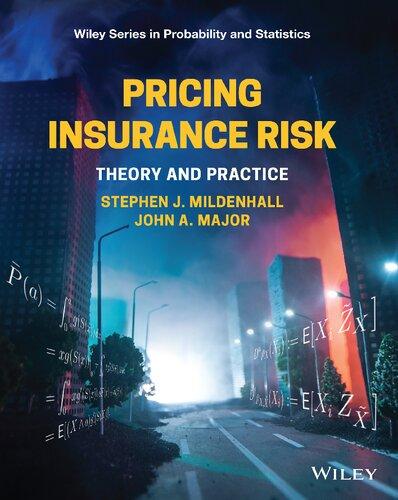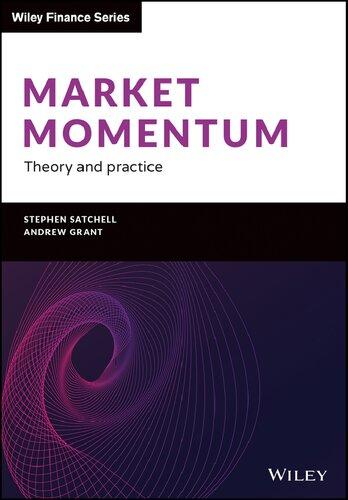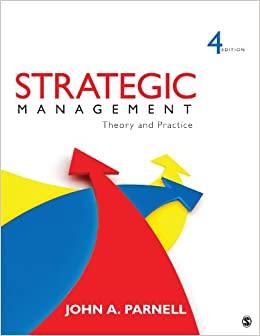J. Mildenhall
Visit to download the full and correct content document: https://ebookmass.com/product/pricing-insurance-risk-theory-and-practice-stephen-jmildenhall/

More products digital (pdf, epub, mobi) instant download maybe you interests ...

Market Momentum: Theory and Practice 1. Edition Stephen Satchell
https://ebookmass.com/product/market-momentum-theory-andpractice-1-edition-stephen-satchell/

Juvenile Delinquency: Theory, Practice, and Law 13th Edition Larry J. Siegel
https://ebookmass.com/product/juvenile-delinquency-theorypractice-and-law-13th-edition-larry-j-siegel/


The Wiley handbook of what works in violence risk management: theory, research, and practice Craig
https://ebookmass.com/product/the-wiley-handbook-of-what-worksin-violence-risk-management-theory-research-and-practice-craig/ Principles of Risk Management and Insurance, Global Editon, 14th Edition George. Mcnamara Rejda (Michael.)
https://ebookmass.com/product/principles-of-risk-management-andinsurance-global-editon-14th-edition-george-mcnamara-rejdamichael/

Foreign Exchange: Practical Asset Pricing and Macroeconomic Theory 1st ed. 2022 Edition Iqbal
https://ebookmass.com/product/foreign-exchange-practical-assetpricing-and-macroeconomic-theory-1st-ed-2022-edition-iqbal/

Creating the Qur’an Stephen J. Shoemaker
https://ebookmass.com/product/creating-the-quran-stephen-jshoemaker/

Finance and Risk Management for International Logistics and the Supply Chain Stephen Gong
https://ebookmass.com/product/finance-and-risk-management-forinternational-logistics-and-the-supply-chain-stephen-gong/

Wood Coatings: Theory and Practice
https://ebookmass.com/product/wood-coatings-theory-and-practice/

Strategic Management: Theory and Practice
https://ebookmass.com/product/strategic-management-theory-andpractice/

StephenJ.MildenhallandJohnA.Major
Thiseditionfirstpublished2022 © 2022JohnWiley&Sons,Inc.
Allrightsreserved.Nopartofthispublicationmaybereproduced,storedinaretrievalsystem,ortransmitted,in anyformorbyanymeans,electronic,mechanical,photocopying,recordingorotherwise,exceptaspermittedby law.Adviceonhowtoobtainpermissiontoreusematerialfromthistitleisavailableathttp://www.wiley.com/ go/permissions.
TherightofStephenJ.MildenhallandJohnA.Majortobeidentifiedastheauthorsofthisworkhasbeenasserted inaccordancewithlaw.
RegisteredOffice
JohnWiley&Sons,Inc.,111RiverStreet,Hoboken,NJ07030,USA
EditorialOffice 111RiverStreet,Hoboken,NJ07030,USA
Fordetailsofourglobaleditorialoffices,customerservices,andmoreinformationaboutWileyproductsvisitusat www.wiley.com.
Wileyalsopublishesitsbooksinavarietyofelectronicformatsandbyprint-on-demand.Somecontentthatappears instandardprintversionsofthisbookmaynotbeavailableinotherformats.
LimitofLiability/DisclaimerofWarranty
Whilethepublisherandauthorshaveusedtheirbesteffortsinpreparingthiswork,theymakenorepresentations orwarrantieswithrespecttotheaccuracyorcompletenessofthecontentsofthisworkandspecificallydisclaimall warranties,includingwithoutlimitationanyimpliedwarrantiesofmerchantabilityorfitnessforaparticular purpose.Nowarrantymaybecreatedorextendedbysalesrepresentatives,writtensalesmaterialsorpromotional statementsforthiswork.Thefactthatanorganization,website,orproductisreferredtointhisworkasacitation and/orpotentialsourceoffurtherinformationdoesnotmeanthatthepublisherandauthorsendorsethe informationorservicestheorganization,website,orproductmayprovideorrecommendationsitmaymake.This workissoldwiththeunderstandingthatthepublisherisnotengagedinrenderingprofessionalservices.Theadvice andstrategiescontainedhereinmaynotbesuitableforyoursituation.Youshouldconsultwithaspecialistwhere appropriate.Further,readersshouldbeawarethatwebsiteslistedinthisworkmayhavechangedordisappeared betweenwhenthisworkwaswrittenandwhenitisread.Neitherthepublishernorauthorsshallbeliableforany lossofprofitoranyothercommercialdamages,includingbutnotlimitedtospecial,incidental,consequential,or otherdamages.
LibraryofCongressCataloging-in-PublicationData
Names:Mildenhall,StephenJ.,author.|Major,JohnA.,author.
Title:Pricinginsurancerisk:theoryandpractice/StephenJMildenhall,JohnAMajor.
Description:Hoboken,NJ:JohnWileyandSons,2022.|Includesbibliographicalreferencesandindex. Identifiers:LCCN2021062792(print)|LCCN2021062793(ebook)|ISBN9781119755678(hardback)| ISBN9781119755692(pdf)|ISBN9781119756521(epub)|ISBN9781119756538(ebook) Subjects:LCSH:Risk(Insurance)|Riskmanagement.
Classification:LCCHG8054.5.M552022(print)|LCCHG8054.5(ebook)|DDC368–dc23/eng/20220111 LCrecordavailableathttps://lccn.loc.gov/2021062792 LCebookrecordavailableathttps://lccn.loc.gov/2021062793
CoverDesign:Wiley
CoverImage: © zefart/Shutterstock
Setin9.5/12.5ptSTIXTwoTextbyIntegraSoftwareServicesPvt.Ltd,Pondicherry,India 10987654321
Dedicatedtoourwives,HelenandDiane
Contents
Preface xii
1Introduction 1
1.1OurSubjectandWhyItMatters 1
1.2Players,Roles,andRiskMeasures 2
1.3BookContentsandStructure 4
1.4What’sinItforthePractitioner? 7
1.5WheretoStart 9
2TheInsuranceMarketandOurCaseStudies 13
2.1TheInsuranceMarket 13
2.2InsCo.:AOne-PeriodInsurer 15
2.3Modelvs.Reality 16
2.4ExamplesandCaseStudies 17
2.5LearningObjectives 25
PartIRisk 27
3RiskandRiskMeasures 29
3.1RiskinEverydayLife 29
3.2DefiningRisk 30
3.3TaxonomiesofRisk 31
3.4RepresentingRiskOutcomes 36
3.5TheLeeDiagramandExpectedLosses 40
3.6RiskMeasures 54
3.7LearningObjectives 60
4MeasuringRiskwithQuantiles,VaR,andTVaR 63
4.1Quantiles 63
4.2ValueatRisk 70
4.3TailVaRandRelatedRiskMeasures 85
4.4DifferentiatingQuantiles,VaR,andTVaR 102
4.5LearningObjectives 102
5PropertiesofRiskMeasuresandAdvancedTopics 105
5.1ProbabilityScenarios 105
5.2MathematicalPropertiesofRiskMeasures 110
5.3RiskPreferences 124
5.4TheRepresentationTheoremforCoherentRiskMeasures 130
5.5Delbaen’sDifferentiationTheorem 137
5.6LearningObjectives 141
5.ALloyd’sRealisticDisasterScenarios 142
5.BConvergenceAssumptionsforRandomVariables 143
6RiskMeasuresinPractice 147
6.1SelectingaRiskMeasureUsingtheCharacterizationMethod 147
6.2RiskMeasuresandRiskMargins 148
6.3AssessingTailRiskinaUnivariateDistribution 149
6.4The IntendedPurpose: ApplicationsofRiskMeasures 150
6.5CompendiumofRiskMeasures 153
6.6LearningObjectives 156
7GuidetothePracticeChapters 157
PartIIPortfolioPricing 161
8ClassicalPortfolioPricingTheory 163
8.1InsuranceDemand,Supply,andContracts 163
8.2InsurerRiskCapital 168
8.3AccountingValuationStandards 178
8.4ActuarialPremiumCalculationPrinciplesandClassicalRiskTheory 182
8.5InvestmentIncomeinPricing 186
8.6FinancialValuationandPerfectMarketModels 189
8.7TheDiscountedCashFlowModel 192
8.8InsuranceOptionPricingModels 200
8.9InsuranceMarketImperfections 210
8.10LearningObjectives 213
8.AShort-andLong-DurationContracts 215
8.BTheEquivalencePrinciple 216
9ClassicalPortfolioPricingPractice 217
9.1Stand-AloneClassicalPCPs 217
9.2PortfolioCCoCPricing 223
9.3ApplicationsofClassicalRiskTheory 224
9.4OptionPricingExamples 227
9.5LearningObjectives 231
10ModernPortfolioPricingTheory 233
10.1Classicalvs.ModernPricingandLayerPricing 233
10.2PricingwithVaryingAssets 235
10.3PricingbyLayerandtheLayerPremiumDensity 238
10.4TheLayerPremiumDensityasaDistortionFunction 239
10.5FromDistortionFunctionstotheInsuranceMarket 245
10.6ConcaveDistortionFunctions 252
10.7SpectralRiskMeasures 255
10.8PropertiesofanSRMandItsAssociatedDistortionFunction 259
10.9SixRepresentationsofSpectralRiskMeasures 261
10.10SimulationInterpretationofDistortionFunctions 263
10.11LearningObjectives 264
10.ATechnicalDetails 265
11ModernPortfolioPricingPractice 271
11.1ApplyingSRMstoDiscreteRandomVariables 271
11.2Building-BlockDistortionsandSRMs 275
11.3ParametricFamiliesofDistortions 280
11.4SRMPricing 285
11.5SelectingaDistortion 292
11.6FittingDistortionstoCatBondData 298
11.7ResolvinganApparentPricingParadox 304
11.8LearningObjectives 306
PartIIIPriceAllocation 307
12ClassicalPriceAllocationTheory 309
12.1TheAllocationofPortfolioConstantCoCPricing 309
12.2AllocationofNon-AdditiveFunctionals 312
12.3LossPaymentsinDefault 324
12.4TheHistoricalDevelopmentofInsurancePricingModels 326
12.5LearningObjectives 337
13ClassicalPriceAllocationPractice 339
13.1AllocatedCCoCPricing 339
13.2AllocationofClassicalPCPPricing 347
13.3LearningObjectives 348
x Contents
14ModernPriceAllocationTheory 349
14.1TheNaturalAllocationofaCoherentRiskMeasure 349
14.2ComputingtheNaturalAllocations 365
14.3ACloserLookatUnitFunding 369
14.4AnAxiomaticApproachtoAllocation 385
14.5AxiomaticCharacterizationsofAllocations 392
14.6LearningObjectives 394
15ModernPriceAllocationPractice 397
15.1ApplyingtheNaturalAllocationstoDiscreteRandomVariables 397
15.2UnitFundingAnalysis 404
15.3Bodoff’sPercentileLayerofCapitalMethod 413
15.4CaseStudyExhibits 421
15.5LearningObjectives 439
PartIVAdvancedTopics 441
16AssetRisk 443
16.1Background 443
16.2AddingAssetRisktoInsCo. 444
16.3LearningObjectives 447
17Reserves 449
17.1TimePeriodsandNotation 449
17.2LiabilityforUltimateLosses 450
17.3TheSolvencyIIRiskMargin 461
17.4LearningObjectives 468
18GoingConcernFranchiseValue 469
18.1OptimalDividends 469
18.2TheFirmLifeAnnuity 472
18.3LearningObjectives 476
19ReinsuranceOptimization 477
19.1Background 477
19.2EvaluatingCededReinsurance 477
19.3LearningObjectives 481
20PortfolioOptimization 483
20.1StrategicFramework 483
20.2MarketRegulation 484
20.3DynamicCapitalAllocationandMarginalCost 485
20.4MarginalCostandMarginalRevenue 487
20.5PerformanceManagementandRegulatoryRigidities 488
20.6PracticalImplications 490
20.7LearningObjectives 491
ABackgroundMaterial 493
A.1InterestRate,DiscountRate,andDiscountFactor 493
A.2Actuarialvs.AccountingSignConventions 493
A.3ProbabilityTheory 494
A.4AdditionalMathematicalTerminology 500
BNotation 503
References 507
Index 523
Preface
PricingInsuranceRiskisatopicofgreatconcerntoactuaries,especiallyproperty-casualty actuaries,ourprimaryaudience.Butitisalsorelevanttothoseworkinginotherfields, includingriskmanagementandEnterpriseRiskManagement,capitalmodeling,catastrophe modeling,financialregulation,andsolvencyassessment.Insuranceriskismanagedthrough pooling,unlikefinancialriskthatismanagedthroughhedging.Thetitlecouldhavebeen PricingNon-HedgeableRisk.
Thebookcameaboutthroughaconfluenceofsupportingfactors.Wehadworkedindependentlyformanyyearsontheproblemofdefiningthevalueofriskmanagementandrisk transfer(especiallyinthecontextofpropertycatastropherisk)and“escapingtheefficient frontier.”DonMangobroughtustogethertoworkwithhimandJesseNickersontopresent amultiparttutorialonspectralriskmeasuresattheCasualtyActuarialSocietySpring2018 meeting.Thetutorialwassosuccessfulthatwefeltitdeservedawideraudienceandset aboutdevelopingamonograph:“SpectralRiskMeasuresfortheWorkingActuary.”Aswe proceededtorefineourthinkingandpresentation,werealizedtherewassomuchmoreto beexplained.Threeandahalfyearsand1200gitcommitslater,wehadthisbook.
Theliteratureisrichwithgoodanswerstomanyfundamentalquestionsaboutinsurance riskthatareconsistentwithfinancetheoryandrelativelyeasytoapply.Muchisknown,in thesenseofbeingoutthereintheliterature,buttoomuchisnot widely knownbypeople whowouldbenefitfromthatknowledge.Actuarialeducationandpracticeinthisarealags thestateoftheart.Wehaveencounteredactuariesstrugglingwithill-definedterminology andconceptswithmultiplenames.Wehaveseenconfusionwroughtbyinappropriateapplicationoffinancetheories(remembertheunderwritingbeta?).OurnewlymintedUSFellows areoftenignorantofthelatestdevelopmentsbecausetheyarenotontheexamsyllabusand therehasnotbeenaneasywaytoincorporatethem.
Thisbookpresentsthesegoodanswersinonesystematicandcomprehensivesourcefor thefirsttime,makingthemmuchmoreaccessibletoactuariesandotherpractitioners.With thisbookweintendtoraisethebarinactuarialeducation,enableclearcommunications,and improvetheefficiencyofactuarieseverywherebydeliveringafreshmapoftheconceptual territory.Wewishwecouldtakecreditforthetheorywepresent,butmostofitisaround twentyyearsold.Wearesimplyreportingtheworkofothers.
Insurancepricingismultidisciplinary,combiningactuarialscienceandrisktheory,probabilityandstatistics,financeandeconomics,accountingandlaw.Asweorganizedand
Preface xiii synthesizedabodyofliteratureasnearlyasoldastheindustryitselftotellthestoryofinsurancepricing,wetriedtobesensitivetoitshistoricaldevelopment—aplaysomeofwhichwe watchedunfoldinrealtime.Itisastorywebothfoundfascinating.Fromdefiningunderwritingprofitandareasonabletargetprofitinthe1920stoargumentsaboutinvestmentincome inthe1960s.Fromsystematicriskandoptionpricingtheoryapplicationsinthe1980stoa moreinsurance-specificmodelinthe1990s.Andmostrecentlytotheintroductionofcoherent,convex,andevenstar-shapedriskmeasures.Wehopethereaderhastimetoappreciate thegiantsonwhoseshouldersweareluckyenoughtostandandcanjoinusintakingin thespectacularvistasofthemeaning,quantification,andmanagementofrisktheyhave revealed.
Inputtingtogetherthisbookwetriedtostayreasonablyrigorouswithoutgettinglostina theorem-proofwilderness.Wefeelstronglythatknowinghowtouseatechniqueisnothelpfulifyouareunsurethatitisvalidtouseinthefirstplace!Weincludetechnicalremarksand providepointersintotheliterature(about300bibliographicreferences)forthosewhowanta morethoroughunderstandingof“why.”Forthepractitioner,weincludednearly100examplesand150exercises.TheLearningObjectivesattheendofeachchaptersummarizewhat wehopethereaderwilltakeawayfromit. Bold wordsandphrasesintroduceterminology thatisusedthroughoutthebook.
Weaimedthisbookprimarilyatproperty-casualtyactuaries,atminimumtwoyearsof experienceasastudentactuarywithbasicknowledgeofinsurancecoverageandstructuring,andhavingpassedthebeginningmathematicsexams.Weexpectreaderswithdifferent backgroundswillstillbeabletogetsomethingfromthebook.Alotoftheinsurance andfinanceterminologyisonlyaninternetsearchaway.Mathematicsbackgroundshould includecalculusandbasicprobability—samplespaces,discretevs.continuousrandom variables,normalandlognormaldistributions,integrationbyparts,etc.Ofcourse,foran in-depthunderstanding,morebackground,especiallyinprobabilitytheory,isbetter.
Themanuscriptwaspreparedusingfreesoftware.ItwaswritteninMarkdownandconvertedtoTeXusingPandoc.TikZwasusedforthefiguresanddiagrams,andallthegraphs andplotsweremadeusingPython,Pandas,andMatplotlib.WeusedRforthestatisticalanalysisandtodoublecheckPython(theyalwaysagreed).Spreadsheetswereusedforthediscrete examples.Webothrememberwhencomputersbootedfrom(genuinely)floppydisks.The existenceofsomuchfreesoftware,ofsuchahighquality,isanunexpectedjoy.
Weoweadebtofgratitudetomanypeople.Inacademia,keepingusaccurate,wethank DaniBauer,StuartKlugman,AndreasTsanakas,RuoduWang,ShaunWang,andGeorge Zanjani.Inbusiness,keepingusreal,wethankAviAdler,JohnAquino,NeilBodoff,Julia Chu,AndrewCox(1978–2021),DanDick,PaulEaton,BryonEhrhart,KentEllingson, StephenFiete,BobFox,JonathanHayes,GregHeerde,WouterHeynderickx,RodneyKreps, MortonLane,MikeMcClane,TessaMoulton,ParrSchoolman,PaulSchultz,JasonTrock, GaryVenter,SteveWhite,andRebeccaWilkinson.
SpecialthanksgotoDonMangoforstartingthisall;toJesseNickersonforhisearly involvementintheresearchandhiscommentsondrafts;andtoYuriyKrvavychand LawrenceMcTaggartfortheircommentsondrafts.RichardGoldfarbstandsoutforparticularthanks,havingprovidedverydetailedandpertinentfeedbackthatresultedinnumerous improvements.Stephen:IwouldliketorecognizetheinfluenceofGlennMeyersandRichard
xiv Preface
Derrig(1941–2018)earlyinmycareer—theytaughtmehowtothinkaboutpricinginsurance risk.Iamenormouslygratefultomywife,Helen,whostartedproofreadingthemanuscript atalatestageandfoundherselflearningthematerialinacrashcourse.Herfreshperspectiveandunyieldingcommitmenttoclarityhelpedimprovethepresentationinuncountably manyways.John:IwouldliketothankJackCaron,BernieShorr,andAaronSternfor openingdoors.
Inordertomakeinsuranceatradeatall,thecommonpremiummustbesufficientto compensatethecommonlosses,topaytheexpenseofmanagement,andtoaffordsucha profitasmighthavebeendrawnfromanequalcapitalemployedinanycommontrade. AdamSmith, TheWealthofNations (Book1,ChX,PartI,5thEdition,1789)
1.1OurSubjectandWhyItMatters
Pricinginsuranceriskisthelastmileofunderwriting.Itdetermineswhichrisksareaccepted ontothebalancesheetandmakesaninsurer’sriskappetiteoperational.Itiscriticalto successfulinsurancecompanymanagement.
Asthelastmile,pricingdependsonallthathascomebefore.Actuariesandunderwriters haveanalyzedandclassifiedtherisk,trendedanddevelopedlosses,andon-leveledpremiumstopickabest-estimateprospectivelosscost.Accountantshaveallocatedfixedand variableexpenses.Simulationmodelsplacethenewriskwithinthecontextofthecompany’s existingportfolio.Themechanicsofallthisworkisthesubjectofmuchoftheactuarialeducationsyllabus:experienceandexposurerating,predictiveanalytics,andadvancedstatistical methods.Thatisnotthesubjectofthisbook!Allofthatprioreffortdeterminestheexpected loss,andwetakeitasagiven.Pricingaddsthe riskmargin—toaffordcapitalareasonable return.Theriskmarginisoursubject.
Sinceriskmarginsareoftensmall,howisittheydeserveawholebook?Becauserisk considerationshaveanoutsizedmarketimpact.True,personalpropertymayonlyearna single-digitmargin.Butthatbusinessoftenreliesonreinsurancepricedwithmarginsof50% ormore.Whenthereinsurancemarketsfailorbecomestressed—asseenafterHurricane AndrewandtheNorthridgeearthquake,forexample—thetailofhigh-risk-marginbusiness wagsthedogofmuchlargerpropertylines.Riskmarginsarecriticaltothefunctioningofthe insurancemarket.Evenforlineswiththinmargins,thecollectiveriskandreturndecisionsof firmshaveprofoundmacroimpactsovertimesuchasthesecularincreasesinhomeowners pricingoverthelasttwentyyears.
Weemphasize insurancerisk.Wedonotdiscusscreditrisknoroperationalrisk.Wehave onlyalittletosayaboutassetriskandnothingaboutinterestraterisk.Marketrisk,underwritingcycles,competitivethreats?Sorry,alloff-topic.Wearefocusedontheriskoflosses arisingfrominsurancecontracts.Weleanheavilytowardsaproperty-casualtyperspective and,withinthat,towardscatastropherisk;however,theprincipleswelayoutapplytoany insurancerisk.ThisisnotabookaboutEnterpriseRiskManagement(ERM)althoughwe dohaveafewwordstosayaboutoptimizationandportfoliomanagement.
Thegoalofthisbookistodemonstratehowto
1. computeareservationprice(technicalpremium,requiredpremium)forthe portfolio, and
2. allocateittoportfolio units (policies,linesofbusiness,etc.)inadefensiblemanner startingfromamodeloftheinsuredrisks.Thesepricingtechniqueshavepowerfulapplications.Theyallowustoassesstheperformanceofdifferentunits,evaluateneededreinsurance,andoptimizeoverallstrategy.
1.2Players,Roles,andRiskMeasures
Figure 1.1 showstheparticipantsintheinsurancepricingproblem.Insureds,left,paypremiumstotheinsurerandinturnreceivelosspayments.Theregulator,ontop,observing theriskthattheinsureristakingon,imposesassetrequirements.Investors,right,provide capitalandinturnreceivetheresidualvalue(remainingassets)afterlossesarepaid.
Insuredsbuyinsurancebecauseoftheiraversiontoriskandbecausetheyarerequired todosotodriveacar,buyahousewithamortgage,etc.Regulatorsplayasocialpolicy role,addressingthreeprincipalconcerns.First,toensuremandatedthird-partyinsurance provideseffectiveprotection.Second,tomanagetheexternalityoflossesexceedingassets. Andthird,topreventinsuredsbeingfleecedbyexcessivepremiums.Thefirstconcernis presentinanytort-basedsystem.WelooselyidentifythesecondasEuropeanandthethirdas
Figure1.1 Playersandtheirroles.Theregulatorappliesacapitalriskmeasuretodetermine requiredinsurerassets.Thepricingriskmeasuregivesthecostofinvestors’capital.Assetsinexcess oflossesarepaidtoinvestorsastheresidualvalueofthebusiness.
American.Wefocusonthesecondconcern,assetadequacy.Ourdevelopmentoftechnical premiumsnaturallyalignswiththethirdfairnessconsiderationifweassumethatcapital marketsrequirefairreturns.
Investorsindirectlydeterminepremiumsbecausepremiumspluscapitaladduptoand fundassets,Figure 1.2.Investors’willingnesstoprovidecapitaltoinsurerstranslatesintoa pricingriskmeasure,whichtheinsurerappliestothecoveredrisks.Premiumandassetlevels areseparateproblemsandneedseparatetools.
Twoimportantquestionsarisefrominsurancecompanypromisestopaycertainsumsof moneycontingentonrandomevents.
1. Aretheresufficientassetstohonorthosepromises?
2. Areinvestorsbeingadequatelycompensatedfortakingonthoserisks?
Crucially,weneedtotalkaboutnotonebut two differentriskmeasurestoanswerthese questions.
Question1concernsrisktoleranceandisusuallyansweredbyaneconomiccapitalmodel. Itdeterminestheassetsnecessarytobackanexistingorhypotheticalportfolioatagivenlevel ofconfidence.Thisexerciseisalsoreverseengineered:givenexistingorhypotheticalassets, whataretheconstraintsonbusinessthatcanbewritten?
Wecanimaginearegulator—interpretedbroadlyasanexternalauthority—consideringa portfolioofrisksthattheinsurerproposestocover.Theregulatorspecifiestheamountof assetstheinsurermustholdtocovertherisk.Ifthereisashortfallafterlossesarerealized,it willbemadeupbypartiesexternaltotheinsurer,e.g.,aguaranteefundorothergovernment entity,ortheinsuredsthemselvesinsofarastheyarenotreimbursedforclaims.Theregulatorseekstominimizethenonpaymentexternality,balancedwithadesireforeconomical insurance.
Acapitalriskmeasureisappliedtoeconomiccapitalmodeloutputtoquantifythelevel ofassetstheinsurermusthold.ValueatRisk(VaR)orTailValueatRisk(TVaR)atsome highconfidencelevel,suchas99.5%or1in200years,arebothpopular,butotherpossible measuresexist.
Question2concernsriskpricingorriskappetite.Wemustdeterminetheexpectedprofit insuredsneedtopayintotaltomakeitworthwhileforinvestorstobeartheportfolio’srisk. Regulatedinsurersareinvariablyrequiredtoholdcapitalonaregulatedbalancesheet.We generallyassumeafundingconstraintwherepremiumandinvestorsuppliedcapitalarethe onlysourcesoffunds.Then,the pricingriskmeasure determinesthesplitoftheirasset fundingbetweenpremiumandcapital.
Thecapitalandpricingriskmeasuresshouldnotbeconfused.Historically,capitalrisk measureshavebeenstudiedinthecontextoffinanceandregulation,e.g., Artzner etal. (1999).Incontrast,actuarieshavestudiedpricingriskmeasuresaspremiumcalculation principles(Goovaerts,DeVylder,andHaezendonck 1984).Therecentpopularityandfocus oncoherentriskmeasureshasovershadowedactuarialpremiumcalculationprinciplesand ledtosomeconfusionaboutthetwodistinctpurposesofriskmeasures.Muchoftherecent literatureimplicitlyorexplicitlyreferstothecapitaldomainonly.However,practitioners dealingwithissuessuchasbusinessunitperformance,premiumadequacy,andshareholder valueareoperatinginthepricingdomain.Takingariskmeasuresuitableforoneuseand applyingittotheotherinvitesunexpectedandconfusingresults.Instead,wemustunderstandhowthecapitalandpricingmeasuresworktogetherinacomplex,nonlinearmanner todeterminetechnicalprices.
Thetop-downpricingprocesswehavedescribedmaynotseemcommonplace,although thoseworkingincatastrophereinsuranceshouldfindourprocessfamiliar.Mostindividualriskpricingactuariescanlegitimatelyclaimtouseabottom-upapproach.Nevertheless, deepwithinalmosteverycompanyliesacorporatefinancialmodelfunctioningexactlyaswe describe.Itasks:Howmuchcapitalisneeded?Whatisthecostofthatcapital?Whatoverall marginisnecessary?And,howshoulditbeallocatedtoeachunit?
1.3BookContentsandStructure
Thebookhasfourmainparts:oneonmeasuringrisk,oneaboutportfoliopricing,oneabout pricingunitswithinaportfolio,andoneaddressingadvancedtopics.Thehighleveloverview weprovideheresupplementstheintroductoryparagraphsineachchapter.
1.3.1PartI:MeasuringRisk
PartIisabout risk.Whatisrisk,andhowcanitbemeasuredandcompared?Wediscuss themathematicalformalismandpracticalapplicationofrepresentinganinsuredriskbya randomvariable.Wedefineariskmeasureasafunctionaltakingarandomvariabletoareal numberrepresentingthemagnitudeofitsrisk.Wegivenumerousexamplesofriskmeasures andthedifferentpropertiestheyexhibit.
Somepropertiesaremoreorlessmandatoryforausefulriskmeasure,andtheyleadus tocoherentriskmeasures.Coherentriskmeasureshaveanintuitiverepresentation,providinguswithsomeguidanceonformingandcomparingthem.Spectralriskmeasures (SRMs)—alsoknownasdistortionriskmeasures—areasubsetofcoherentmeasures.They haveadditionalpropertiesandaparticularlystraightforwardrepresentationviaadistortion function.Spectralriskmeasurescanbeviewedinfourequivalentways:
1. asexpectedvalueswithvaryingdistortedprobabilities,
2. asaweightedsumofTVaRsatdifferentthresholds,
3. asaweightedsumofVaRsatdifferentthresholds,wheretheweightshavespecific properties,and
4. astheworstexpectedvalueacrossasetofdifferentprobabilityscenarios.
Spectralriskmeasuresalterordistorttheunderlyingpatternofprobabilitiesandcompute expectedvaluesbasedonthenewprobabilities,analogoustotheeffectofstochasticdiscount factorsinmodernfinance.Thedistortedprobabilitytreatslargelossesasmorelikely,creating apositivepricingmargin.TVaRisthearchetypalSRM.Itissimpleyetpowerfulandhas manydesirableproperties.WegainanalyticalinsightsintothenatureofSRMsbecausethey areallweightedaveragesofTVaRs.Forexample,wecanallocateanySRM-derivedquantity bybootstrappingaTVaRallocation.
1.3.2PartII:PortfolioPricing
PartIIisabout portfoliopricing,wheretheentireportfolioistreatedasasinglerisk.Risk isrelatedtoreturn,suggestingweshouldapplyariskmeasuretoportfoliolossesandusethe resulttoindicateaprice.Ourprincipalgoalistodeterminewhatpriceissufficientforassumingtheportfoliorisk.Secondarygoalsincludeunderstanding,makinginferencesabout,and calibratingto,marketprices.
Insuranceischaracterizedbyrisktransferthroughriskpooling.Figure 1.1 combinesall insuredsintooneportfolio.Itshowshowthecapitalandpricingriskmeasuresinteractto determinetheinsurer’sriskpoolpremium.PartIIofthebooktreatsthecashflowsonthe lowerright,betweentheinsurerandtheinvestors.
Weareawarethatpricingactuariesandunderwritersdonotsetpremiums;marketsdo. However,theaggregateeffectofindividualcompanyrisk-returndecisionsdrivesquotesand acceptancesinthemarket.Whenwetalkaboutsettingpremiums,weunderstanditinthe frameworkofevaluatingmarketpricingorofferingaquote.
Howaretheparametersofapricingmodeldetermined?Thisisadifficultquestionthat mustbeansweredtoputtheoryintopractice.Weprovideexamplesshowinghowdifferent parametrizationmethodsperform,linkpricingtocapitalstructure,andcalibrateanSRMto catastrophebondpricing.
1.3.3PartIII:PriceAllocation
Insurersmustallocateaportfoliopriceandmargintoitsconstituentunitstosellpoliciesand runtheirbusiness. Priceallocation isthetopicofPartIII.
Weexaminehowunitscontributetoportfoliorisk.Forexample,themodelsmayshowseveraloutcomesthatleadtoinsolvency.Whichunitsarethedriversoflossesinthosescenarios? Parallelquestionscanbeaskedofother,lesscatastrophic,levelsofloss.
Havingcomputedtechnicalpremiumsasdistortedexpectedvalues,wecanthenapply thesamedistortedprobabilitiestounitlosses,basedontheirco-occurrencewiththetotal portfoliolosses,toallocatethepremiumstounits.Thistechniqueprovidesahighdegreeof consistencyandsynchronizationincalculatingtechnicalpremiumsbyunit.
Thereisaparticularapproachtohandlingbusinessunitperformanceassessmentand reinsurancedecisionmakingthatmakesuseofacapitalmeasure,typicallyVaRorTVaR, butappearsnottomakeuseofapricingmetric.Thisapproachisrootedinreturnonriskadjustedcapitalstylefinanciallogic.Ittakestwosteps:allocatecapitalandthenassignacost
ofcapital hurdlerate thateveryunitmustmeetonitsallocatedcapital.Alldecisions,such asreinsurancepurchases,usethesamecostofcapitalasabenchmark.
Practitionersrecognizethatthisapproachtendstoplaceuncomfortablylargeburdenson catastropheexposedunitsrelativetounitsthatdonotparticipatemuchinsolvencythreateningevents.Inaddition,whenappliedtoreinsurancepurchasing,ittendstofavor,almost withoutexception,dealsthatoperateathighlevelsoflosswithlowprobabilities.Weshow thattheproblemherestemsfromtheimplicituseofwhatwecalltheConstantCostofCapital(CCoC)SRM.Theoverallhurdleratefortheentireportfoliomaynotbeappropriatefor everyunit.Whatisneededisapricingriskmeasure—different fromCCoC—thatresponds tovaryinglevelsofriskinesswithdifferentrequiredratesofreturn.WhereasPartIIdiscusses theconstructionofsuchmeasures,PartIIIdiscusseshowtodeploythem.
1.3.4PartIV:AdvancedTopics
Thelastpartofthebooktouchesonfivetopicsthatgobeyondthecoverageofprevious chapters:assetrisk,reserves,goingconcernandfranchisevalue,reinsuranceoptimization, andportfoliooptimization.
1.3.5FurtherStructure
PartsIIandIIIdivideportfoliopricingfromallocationconsiderations.Withineachpart, wefurtherdistinguishclassicalfrommodernapproaches,andtheory frompractice.The hierarchy,reflectedinthesequenceofeightcorechapters,is:
● Chapters 8 and 9:classicalportfoliopricingtheoryandpractice,
● Chapters 10 and 11:modernportfoliopricingtheoryandpractice,
● Chapters 12 and 13:classicalpriceallocationtheoryandpractice,and
● Chapters 14 and 15:modernpriceallocationtheoryandpractice.
Ourdividinglinebetweenclassicalandmodernis1997,theaveragepublicationdateof threehighlyinfluentialpapers.RelatingtoPartI: Artzner etal. (1997)introducedcoherent riskmeasuresandrevolutionizedthinkingaboutmeasuringrisk.RelatingtoPartII: Wang (1996)introducedthepremiumdensityanddevelopedthetheoryofpricingbylayer.And, relatingtoPartIII:Phillips,Cummins,andAllen(1998)rigorouslyderivedfinancialpricesin amultilinecompanyaccountingfordefault.Theclassicalversusmodernbifurcationserves aconvenientorganizationalpurposebutshouldnotbetakentooseriously.
Classicalpricingispredominantlyactuarialandrisktheoretic.Astabilityrequirement, oftenlinkedtotheprobabilityofeventualruin,determinesrequiredassets.Thereisno directconsiderationofthecostofcapital.Ontheotherhand,modernapproachescombine risktheorywithfinancialandmathematicaleconomicsanddecisionscience.Theyrelate risktotheinvestors’returnandthecostofcapitalandpayattentiontouncertaintyandrisk underpooling.Theyleveragepowerfulmathematicstounderstandintuitivelyreasonable riskmeasures.
1.4What’sinItforthePractitioner?
Thisbookisintendedtobeapractitioner-friendlyreferenceaswellasprovidingatheoretical framework.Ourmethodsmusthaveafirmtheoreticalfoundationtojustifytheirrealworld application.Manytopicsareinherentlytechnicalandrequireamathematicalbackgroundto understandfully.Atthesametime,themethodswedescribecanandshouldbeimplemented inpractice.Wehavestructuredthebooksoreaderseagertogettheirhandsdirtycandothat moreeasily.ThroughoutPartsIIandIII,wealternatetheoreticalandpracticalchapters.The Practicechapterspresentarangeofsimplenumericalexamplesandapplyallthemethods weproposetothreerealisticCaseStudies.
Wealsopaymoreattentiontoinstitutionalarrangements—thewaythingsgetdone— thanthetypicaltheoreticalpresentation.Differentformsofcapital,capitalcomparedto equity,accounting,andthemechanismofdefault,especiallyequalpriority,allplayessentialroles.Furthermore,weaddresscertainstandardpracticesintheindustryandsubsume themwithinouranalyticalframeworksothereadercanbetterappreciatetheirproperties andbehavior.
Overtheyearswehavefoundthatputtingthesetoolsandtechniquesintopracticeraisesthe followingquestions.
WhichriskmeasureshouldIuse?Acommonfollowupquestionasksiftheriskmeasure shouldbesensitivetothetailofthedistributionorvolatilityinthebody,whichtranslatesinto aconcernaboutsolvencyvs.quarterlyearnings.Asalwaysinmodeling,themeasuremust beappropriatetotheintendedpurpose.Ourframeworkseparatestheamountofcapitalfrom itscost:thecapitalriskmeasureisnecessarilytailfocused,whereasthepricingriskmeasure capturesinvestorreturnexpectations.Additionally,theconnectionbetweencapitalstructure andthe pricing riskmeasureisafundamentalinsight.
HowdoIreconcileandmanagedifferenteconomicandregulatoryviewsofrisk?
Oftenfollowedby,“Whocares?Wemanageto[RatingAgency’s]capitalmodel”.Weagree: youdon’tcare.Theratingagencymodelisabindingconstraintonthe amount ofcapitalfor manyinsurers.Youcontroltheformandinfluencethe cost ofcapital.Again,tworiskmeasures.Itisn’taquestionofreconciliation;itisaquestionofunderstandingeachmeasure’s distinctpurposes.
Shouldpricingtargetareturnonallcapital,orcantherebe excesscapital? Genuinelyexcesscapitalisexceptionallyrare.Ourmodelproducesacostofcapitalspecific toeachcompany,whichvarieswiththeamountofcapital.Abettercapitalizedcompany hasalowerpercentagecostofcapital,otherthingsbeingequal,becausehigherlayercapitalislessstressedandexposedtorisk.Asaresult,theproblemofapplyingauniformly highcostofcapital,producinguneconomicpremiums,shouldnotoccur.Thefrictionalcosts ofcapitalare,however,constantforalllayersofcapital.Indeed,theycouldbeincreasing ifthemanagementofovercapitalizedcompanieshasanincentivetoengageinfrivolous, self-aggrandizingactivities.
HowdoIdeterminethecostofcapital?Doesitvarybyunit? Theriskcostofcapital istheweightedaveragecostovertheactualcapitalused.Debtandreinsurancehaveknown
costs.Thecostofequitycapitalisnormallyestimatedusingapeerstudy.Thecostofcapital variesbyunitaccordingtowhichcapitallayerseachunitconsumes.Thefrictionalcostof capitaltypicallydoesnotvarybyunit.
Canriskmarginseverbenegative?Classicalandmodernapproachestopricingareunanimousthattheriskmarginmustbepositivefortheportfolio.However,negativemargins areappropriateforsomeunitswithintheportfolio.Theyoccurforunitsthatarehedges, withlossesarisingmoreinsituationswheretheportfoliohaslowerlossesandlesswhenthe portfoliohasmoresignificantlosses.Thecommonpracticeofpayingapositivemarginfor cededreinsuranceprovesthepoint:theoutwardcashflow(premium)isgreaterinexpectationthantheinwardcashflow(recovery).Lookingatexpectationsmakesreinsuranceseem inappropriate,butthekeytothevalueofreinsurance(oranyhedge)iswhenthosecashflows occur.
HowdoIuseariskmeasuretodeterminereservationprices? Chapter 10 and Chapter 14 showhowpricingandcapitalriskmeasurescombinetodeterminepremiums. Chapter 20 offerssomemoreadvancedconsiderations.
Thereaderwillrecognizeagapbetweenoursimplifiedmodelsofinsuranceoperations andthecomplexityoftherealworld.ThepractitionerwhohasmasteredPartsI,II,andIII andisstartingtothinkseriouslyaboutimplementingriskmeasureswilllikelycomeupwith numerous“Whatabout...?”questions.Thefollowingmoreadvancedquestionscommonly ariseforinsurerswithfunctioningandintegratedriskpricingsystems.Theyareaddressed inPartIV.
HowdoIhandleassetrisk? HowdoIincorporateriskyassetsinthemodel?Howmuch capitaldoesassetriskconsume?ShouldItreatassetriskinafundamentallydifferentway frominsurancerisk?Weconcludethatanadditionaldegreeoffreedomemerges,butnotto anygooduse.Section8.8discussestheimpactofassetriskonpricingandthemarketvalueof equityinanoptionpricingmodel.Chapter 16 showsthatinvestinginariskyassettypically lowers thefairprice(andquality)ofinsurancebeingsold.
HowdoIpriceforreserverisk? Iwritebusinessthattakesyearstosettle.Itisunrealistictoassumealllossesarepaidinoneyear.HowdoIincorporatereservesintothemodel? Reservevolatilityconsumesunderwritingcapacity.However,ourmodelshowsthattheallocatedmarginsaresmallwhenreservesarestable.Inasense,reservescanprovideballastfor theprospectiveportfolio.IFRSandotheraccountingconventionshavebeguntorequirea riskmarginforreservesforbetterearningsrecognition.WediscusstheSolvencyIICostof CapitalRiskMarginandarealoptionapproachtoreservesinChapter 17.
HowdoImanageagoingconcern?Idon’tmanageforjustoneyearandthendissolvethe business;Imanageagoingconcernwithbrandrecognitionandfranchisevalue.Howdoes thatchangethemodel?Chapter 18 outlinesthetheoryof optimaldividends andasimple modeloffranchisevalue.
HowcanIoptimizecededreinsurancepurchases? Icanseehowassumedreinsurance canbetreatedassellinganotherlineofbusiness,buthowdoIthinkaboutcededreinsurance?
Morespecifically,howshouldIgoaboutoptimizingit?Chapter19discusseshowtoevaluate andoptimizeacededreinsuranceprogram.
HowcanIoptimizemyinsuranceportfolio? Iusedtothinkaboutoptimizingmy capitalusageagainstcapitalconstraints.NowIthinkIshouldbeoptimizingmycostof capital,butthatdoesn’tseemtobewhatyouarerecommending.Isthereadisconnect here?Chapter 20 exploresthecomplexinteractionofcostallocation,benefitallocation,and premiumregulation.Ituncoverssomeunavoidablemarketdistortions.
1.5WheretoStart
Ifyouhavereadthisfar,youlikelyhaveapricingproblem.Itmaybeembeddedina broadereffort—businessunitassessmentorportfoliooptimizationorstrategicplanning— butitcomesdowntoapricingproblematitscore.Atahighlevel,ourrecommendations soundsimple:
1. Establishyourassetrequirement.
2. Establishyourportfoliocostofcapital.
3. Selectandcalibrateaconsistentspectralriskmeasure.
4. Usewhatwecallthenaturalallocationtoallocatethemargintoeachunit.
Theserecommendationspresumealotofworkhasalreadybeendone:gatheringandorganizingrelevantdata,developingamathematicalmodelornumericaltabulation(simulated sample)oftheportfoliorisks,establishinglosscostestimatesfortheunits,etc.Aswesaid, pricingisthelastmile.
Theassetrequirementshouldbeeasytodeterminesinceanexternalauthorityusually promulgatesit.However,itmayrequiresomeworktocompute,usingastandard(e.g.,regulatory)capitalriskmeasure.Ifyoufindnoobviousbindingcapitalconstraint,remember thatmanagement’srisktoleranceisirrelevant;onlytheowner’srisktolerancematters.Tryto divineit.Thisstepcanbeincrediblychallengingformutualcompanies.Ifyouareengaged inanoptimizationproject,thenacapitalriskmeasureisnecessarybecauseyouwillhaveto what-ifthecapitalrequirement.Iftheprobleminvolvesthecurrentportfolioonly,sayabusinessunitprofitabilityassessmentorreinsurancepurchasedecision,youneedonlycalculate currentrequiredassets.
Theportfoliocostofcapitalmaysimilarlybehandeddownfromonhigh.Itcanbe expressedasarateofreturnoramonetarymarginamount;theseareinterchangeablerepresentations.Intheunlikelycaseyougettosetyourportfolioprofitabilitytarget,youneed toexamineyourfirm’sbalancesheet—fortunately,thisisrequiredinthenexttask.
Selectingandcalibratingapricingriskmeasure—specificallyaspectralriskmeasure— isthebiggestchallenge.Wehaveevolvedawayfromourearlyfondnessforparticular parametricSRMs(especiallytheonesweinvented).Wenowrecommendusingbespoke nonparametricorsemiparametricdistortionfunctionstomorecloselymirroractualfundingcosts.Itmaybethatyouarenotmodelingtheentirefirm’sportfoliobutonlyapartofit.
Ifyoudonothaveaccesstothewholecompanyriskprofile,fearnot.Youshouldtreatthe taskasiftheparentcompanyistheinvestorandtheportfolioisthecompany—eventhough thisisacaseofsuboptimizing.ThepointhereisthattheSRMgivesshapetohowtheoverall requiredmarginisdistributedacrosslayersofassetsatrisk.Morespecificadviceonselecting adistortionfunctionisgiveninSection 11.5
Withtheseinputsinhand,allocatingmarginviathenaturalallocationisalmostatrivial numericalexercise.
Ofcourse,wehopeyouwillreadthewholebookeventually,butwearenotsonaïveas toassumeyouhavethetimetositdownandreaditcovertocover.Ittakesalotmoreto explainandunderstand why than how.Whyspectralriskmeasuresmakesenseanddonot violatethereceivedwisdomoffinancetheory,andwhythenaturalallocationisjustifiedin beingtreatedascanonicalandnotmerelyoneofmanyequallyacceptablealternatives— theseissuestakemanymorepagesthanexplainingthemechanicsofcomputation.Wehope youwillappreciatethewhyandreadthewholebook.Butifyouwanttojumpaheadtoa quickgraspofthehow,werecommendthefollowing.Makesuretodoenoughoftheexercises asyougoalongtofeelsecurethatyou“getit.”
● ReadabouttheinsurancemarketandInsCo.,ourmodelcompany,inChapter 2.
● ReviewtheintroductorymaterialonriskmeasuresinChapter 3.Thisshouldbematerial youalreadyknow.ButdopayspecialattentiontotheLeediagraminSection 3.5.
● SomeofthematerialonVaRandTVaRinChapter4maybenewtoyou,somakesureyou arecomfortablewiththebasics.
● Section 5.1 laysoutthebigpictureofhowInsCo.approachesthetaskofanalyzingits capitalandpricingneeds.
● ReadthepracticalapplicationsinChapter 6 andGuidetothePracticeChapters, Chapter 7.
● ReadaboutclassicalrisktheoryinSection8.4andtheDCFmodelinSection8.7.Thiswill helptiethelatermaterialbacktomaterialyoulikelyhavealreadyseen.
● Seehowclassicalpremiumcalculationprinciplesworkoutonourcasestudiesin Section 9.1.
● ReadthesectionsinChapter 10,ModernPortfolioPricingTheory,downthrough Section 10.8.ThisiscoretheoryaboutSRMs.
● ReadandworkexamplesinChapter11,ModernPortfolioPricingPractice,downthrough SelectingaDistortioninSection11.5.Readthislastsectiontwiceandbookmarkitforthe dayyouneedtoselectadistortionforyourownpurposes.
● BrowseClassicalPriceAllocationTheory,Chapter 12,downthroughLossPaymentsin Default,Section 12.3.Thisismaterialthatshouldbemoreorlessfamiliartoactuaries.
● SeehowclassicalpriceallocationworksoutonourCaseStudiesinChapter 13.
● ReadthefirsttwosectionsinChapter14,ModernPriceAllocationTheory.Thiscoversthe naturalallocationofacoherentriskmeasure,propertiesandcharacterizationofallocations,computationalalgorithms,andcommentsonselectinganallocation.Thisisthecore theoryaboutallocatingSRMs.Ifyouarelookingforwaystovisualizemultidimensional risk,readSection 14.3,especiallySection 14.3.7,aswell.
1.5WheretoStart
● ReadModernPriceAllocationPractice,Chapter 15.Thisisessential“how-to”material.
● Ifreservesfeatureprominentlyinyourproject,youmaywanttoreadChapter 17 inPart IV.ThisalsocoverstheSolvencyIIriskmargininSection 17.3.
● Ifreinsurancepurchasingfeaturesprominentlyinyourproject,youmaywanttoread Chapter 19
● Ifyouareworkingwithportfoliooptimization,youmaywanttoreadChapter 20.
Inthischapter,weoutlinetheoperationoftheinsurancemarketaswemodelitanddescribe thehypotheticalInsCo.usedinourexamples.WethenintroduceaSimpleDiscreteExample andthreemorerealisticCaseStudieswhichareusedthroughoutthebooktoillustratethe methodspresentedinthetheorychapters.
2.1TheInsuranceMarket
Insurersareoneperiod,limitedliability entitieswithnoexistingliabilities.Weconsider multi-periodinsurersinPartIVonly.TheinsureriscalledInsCo.Itsellsinsurancepolicies to insureds or policyholders.Policyholderandinsuredaretreatedassynonyms,andboth include claimants.InsCo.’s portfolio isthecollectionofpoliciesitwrites.Thelengthof theperiodisusuallyoneyear.Itslengthisrelevantonlybecauseofthetimevalueofmoney, sinceinterestisarateperyear.
Policyholderliabilities areanyamountsInsCo.owestopolicyholders.Thetwobiggest arelossreservesandunearnedpremiumreserves.WeincorporatereservesinPartIVonly.In property-casualtyinsurance,lossreservescoverclaimsthathavebeenincurredbutnotpaid, whetherreportedornot.Inlifeinsurance,liabilitiesincludepolicyvaluesforlongduration contracts.
Assets arethetotalfinancialresourcesownedbyInsCo.thatitcanusetomeetitspolicyholderliabilities.Aregulatorusuallystipulates requiredassets,aminimumamountof assetsthatInsCo.musthold;seeSection 1.2.
InsCo.,likeallfirms,financesitsassetsbyissuing liabilities.Itsellspolicies,creating policyholderliabilities,inexchangeforpremiums,anditraisescapitalfrom investors by sellingthemitsresidualvalue(equity)orotherpromises(debt,reinsurance).
InvestorscanbeshareholderswhenInsCo.isastockcompanyorinsuredswhenitisa mutualcompanyordebtholdersorreinsurers.
Insurersareintermediariesbetweeninsuredsandinvestors.Intermediaryalwaysmeans aninsurancecompanyintermediary,andneveranagentorbroker. PricingInsuranceRisk:TheoryandPractice,FirstEdition.StephenJ.MildenhallandJohnA.Major. © 2022JohnWiley&Sons,Inc.Published2022byJohnWiley&Sons,Inc.
Portfoliocomponentsarereferredtoas units.Aunitcanbeasinglepolicyoragroup ofpoliciesorbedefinedbyline,geography,branch,businessunit,orothercharacteristics. Unitcanalsorepresentthesegmentationbetweenreinsurancecededlossesandretained losses.
InsCo.’s aggregateloss isthesumoflossesfromitsportfoliooveroneperiod.
InsCo.’soperationsarecontrolledbyeightvariables:(expected)loss,premium,assets, margin, capital, lossratio, costofcapital,and leverage.Thefirstfivearemonetary quantities,andthelastthreeareunitlessratios.Theyobeyfiverelationships:
1. premiumequalslossplusmargin,
2. assetsequalpremiumpluscapital,whichwecallthe assetfundingconstraint,
3. lossratioequalslossdividedbypremium,
4. costofcapitalequalsmargindividedbycapital,and
5. assetleverageequalsassetsdividedbypremium.
Figure2.1laysoutthesevariablesandrelationships.Monetaryquantitiesarethevertices,the bolddiagonallinescorrespondtotheratios,andthetwoshadedtrianglessignifytheasset andpremiumsumconditions.
Premium istheamountchargedforprovidinginsurance.Premiumisnetof(i.e., excludes)underwritingexpensesbutincludesanallowanceforriskcalledthe margin Profit,profitload,profitmargin,riskmargin,andriskloadareallsynonymsformargin.
Premiumisthecriticalvariable;itisthefoundationoftheschematic.Itisthebridge betweeninvestorcashflowsontheleftandinsurancecashflowsontheright.Attheexpected outcome,premiumisshared,withmarginflowingtoinvestorsandexpectedlosstothe insured.
Policyholdersareliablefortheirexpectedloss—asAdamSmithpointedoutin1789;by “commonloss”hemeansexpectedloss.Financingtheremainingassetsisthe sharedliability ofpolicyholdersandinvestors.Thesharedliabilityequalsassetsminusexpectedloss, orequivalentlycapitalplusexpectedmargin. Pricingapportionsthesharedliabilityto policyholdersandinvestors
Thelossratioistheratiooflosstopremium.Becausepremiumsexcludeexpenses,a90% lossratioincludesahealthymargin.Thepremiummarkupistheinverseexpectedlossratio,
Figure2.1 Theeightvariablesthatcontrolinsurance operationsandfiverelationshipsbetweenthem.
theratioofpremiumtoexpectedloss.Catastrophebondpricingoftenquotesmarkupsrather thanlossratios. Premiumleverage referstotheratioofpremiumtocapital.
Themarginisdistinctfromthe contingencyprovision,whichthe ActuarialStandards Board (2011)definesasacorrectionforpersistentbiasesinratemaking.Itsaysthe“contingencyprovisionisnotintendedtomeasurethevariabilityofresultsand,assuch,isnot expectedtobeearnedasprofit.”
A catastrophe or catastropheevent referstoansingleeventcausinglosstomultiple units,suchasahurricane,typhoon,earthquake,winterstorm,terroristattack,orpandemic. Acatastrophelossisthetotallossacrossallunitsfromacatastropheevent.Acatastrophe unitmeansaunitpronetocatastrophelosses.Acatastropheriskisaperillikelytoresultin catastrophelosses.Catastropheriskstendtoattractlargemargins,makingthemparticularly interesting.
Atvariouspointswementioncatastrophemodels.Thesearecomputersimulationtools usedtoestimatepotentialcatastrophelossesfromaninsuranceportfolio. Mitchell-Wallace etal.(2017)provideshelpfulbackgroundabouttheoperationanduseofcatastrophemodels. Lossesina thick-tailed unithaveahighcoefficientofvariation,areright-skewedand leptokurtic(highkurtosis),andhaveasignificantprobabilityofassumingaverysubstantial value.Catastrophelossesareusuallythick-tailed.
A long-tailed unithasaslowpayoutpattern,meaningclaimsarenotsettleduntilmany yearsaftertheyoccur.
Reinsuranceisatypeofinsurance,sowesayinsurancetocoverboth,andreinsuranceif thatisallwemean.Cedentscedebusinesstoreinsurers.
Theaccountingdistinctionbetweencapitalandequitycausesunnecessaryconfusion.
Capitalreferstofundsintendedtoassurethepaymentofobligationsfrominsurancecontracts,overandabovereservesforpolicyholderliabilities.Capitalisalsoreferredtoas net assets.Thebookvalueofcapitaldependsonaccountingconventions.Capitalisusually regulatedbystatute. Surplus isasynonymforcapitalusedinUSstatutoryaccounts.
Equity isthevalueoftheowner’sresidualinterest.Inastockcompany,itiscalled shareholder’sequity.Accountingequityistypicallylowerthancapitalsincedebtcanbe includedincapitalbutnotequity.Equityalsohasamarketvalueforpublicstockcompanies,basedonthevalueofsharesoutstanding.Equitylevelsarenotregulated.Accounting equitycanbenegative.Themarketvalueofequityisalwaysnon-negativebecauseoflimited liability.
Inthissection,weintroducethehypotheticalinsurercalled InsCo.,thatweuseasthe baseforourtheoryandexamples.InsCo.isalimitedliabilitycompanythatintermediates betweeninsuredsandinvestors.
InsCo.’scustomersareinsuredswhoaresubjecttoriskstheywishtoinsure,forthethree reasonsexplainedinSection8.1.1.Insuredswhouseinsuranceforrisktransferorfinancing
